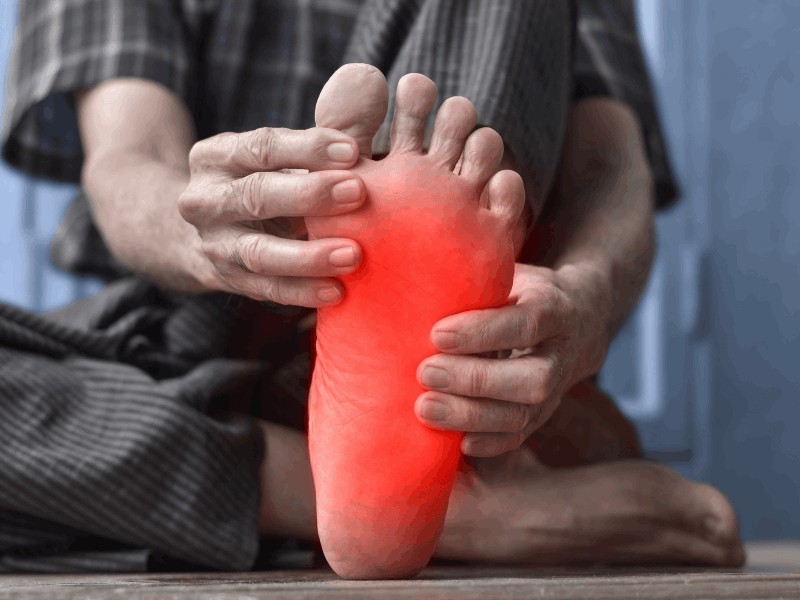Neck Pain Relief: Expert PT Insights and Solutions for Better Mobility
Neck pain is a common ailment that affects millions of people worldwide, with a significant impact on daily life and overall well-being. Whether it stems from abnormal posture, an underlying medical condition, or the stresses of daily life, the discomfort and limitations it brings can be a major hindrance in living your best life.
Studies show that neck pain is not only prevalent but is also one of the leading causes of disability, affecting individuals across all age groups.. For instance, the Global Burden of Disease Study from February 2024 highlights neck pain as a top contributor to years lived with disability (YLDs), underscoring its widespread impact. It also Highlights that Globally, women have higher rates of neck pain than men, with the prevalence peaking between 45 years and 74 years in both sexes.
Why is this relevant to you? In today's digital age, where many of us spend hours hunched over computers or peering into smartphones, the risk of developing neck issues has significantly increased. The sedentary lifestyle, coupled with poor ergonomic practices, has made neck pain more common than ever. This reality brings to light the importance of understanding neck pain, recognizing its causes, and taking proactive steps towards prevention and relief.
By continuing to read, you will gain expert insights into the nature of neck pain, including its symptoms, causes, and the latest evidence-based treatments. Our goal is to empower you with knowledge and practical solutions that can enhance your mobility, reduce discomfort, and improve your quality of life. Through a blend of professional medical resources and physical therapy expertise, this article will serve as your comprehensive guide to navigating neck pain, offering you the tools and confidence to address it effectively.
What is Neck Pain?
Neck pain is a common condition that manifests as discomfort in any part of the neck, ranging from the bottom of the head to the top of the shoulders. It can extend to the upper back and arms, affecting mobility, strength, and the ability to perform daily activities. The pain can vary in intensity, from a mild annoyance to severe pain that restricts movement and impairs quality of life.
At its core, neck pain is more than just a physical sensation; it's a signal from your body indicating that something is amiss. This could be due to acute injury, such as a sprain or strain, or stem from chronic issues like degenerative diseases. Pain in the neck can also arise from lifestyle factors, including poor posture during work or sleep, repetitive motions, or prolonged use of electronic devices without proper ergonomic support.
The implications of neck pain on an individual's quality of life cannot be overstated. It can lead to significant discomfort, limit the range of motion, and interfere with sleep, thereby affecting both physical and mental health. For many, the condition is a barrier to enjoying everyday activities, leading to frustration and, in some cases, a decreasing ability to live a productive life. If gone untreated, it can lead to a progression of pain and symptoms throughout the back and body.
Symptoms of Neck Pain
Neck pain, as a multifaceted condition, presents itself in various ways, depending on the underlying cause and individual circumstances. It's important to recognize that symptoms can range widely from person to person, and what one individual experiences may not be the same as another.
- Here is a detailed and comprehensive list of symptoms frequently associated with neck pain:
- Dull Aching or Sharp Pain: This can occur directly in the neck area and might be constant or only when moving the neck in certain ways.
- Stiffness or Reduced Mobility: Many individuals experience difficulty turning or bending their head from side to side or bending forward and backward, which can significantly impact daily activities.
- Muscle Tightness or Spasms: Sudden, sharp muscle contractions in the neck area are not uncommon, sometimes leading to persistent muscle tightness.
- Headaches: Headaches may originate at the base of the skull and radiate towards the forehead.
- Radiating Pain: Pain can extend beyond the neck to the shoulders, arms, or even fingers. This symptom is sometimes associated with nerve compression or irritation.
- Numbness or Tingling: A sensation of "pins and needles" or loss of sensation in the arms, hands, or fingers may occur, potentially indicating nerve involvement.
- Fatigue: Some individuals also report feeling generally tired or experiencing a decrease in energy levels, likely due to the discomfort and its impact on sleep.
- Difficulty Concentrating or Irritability: The discomfort and constant management of neck pain can affect mental health, leading to difficulty focusing on tasks and/or increased irritability.
It's crucial to understand that these symptoms can sometimes indicate more serious conditions, especially if they are severe, persistent, or accompanied by other signs like weight loss, fever, or weakness. Therefore, it's advisable to seek professional physical therapy care for a thorough assessment and appropriate management. Whether you are looking for physical therapy for neck pain in Bellevue, Washington or elsewhere, our team is here for you.
Causes of Neck Pain
Neck pain is a symptom that arises from a variety of sources, each contributing to the discomfort in its unique way. It's essential to recognize that while these factors are frequently associated with neck discomfort, they are not direct causes in every case.
- Muscle Strain and Tension: Often, neck pain is the result of muscle strain or tension. This can be caused by activities that involve prolonged posture or sudden movements, such as sitting at a desk for extended periods, sleeping in an awkward position, or engaging in repetitive neck motions.
- Injury and Accidents: Trauma from falls, sports injuries, car accidents, or other sudden impacts can cause whiplash, herniated discs, or other injuries that lead to neck pain.
- Wear and Tear: Osteoarthritis is a common condition that affects the joints, including those in the neck. Over time, the wear and tear on the cartilage can lead to pain and stiffness.
- Nerve Compression: Herniated discs or bone spurs in the vertebrae of your neck can press on the nerves branching out from the spinal cord, resulting in pain.
- Diseases: Certain diseases, such as rheumatoid arthritis, meningitis, or cancer, can cause pain in the neck as a symptom.
- Degenerative Disc Disease: As people age, the intervertebral discs can degenerate, leading to reduced cushioning between the vertebrae and potential neck pain.
- Poor Posture: Chronic poor posture, especially related to the use of computers and mobile devices, can strain neck muscles and ligaments, leading to pain over time.
- Stress: Psychological stress can lead to muscle tension in the neck, manifesting as pain.
It's crucial to approach the management of neck pain with a comprehensive understanding of these potential causes. Sometimes, a combination of factors may be at play, necessitating a multifaceted treatment approach.
Treatment Options for Neck Pain
No two necks are the same, so managing neck pain effectively requires a personalized approach with a thorough assessment, as the best treatment plan varies depending on the individual's symptoms, the underlying causes, and their lifestyle.
Here's an overview of various treatment options available for neck pain, each with its specific application and benefits:
- Physical Therapy: Physical therapy is often the initial cornerstone of treatment for neck pain. It involves a combination of neck stretches and exercises, manual therapy and posture education all focusing on techniques to reduce pain and improve function. Physical therapists tailor their approach to address the root cause of your pain, focusing on strengthening and flexibility exercises that can help alleviate pain and prevent future episodes.
- Medication: Over-the-counter pain relievers, such as ibuprofen or acetaminophen, can be effective for mild to moderate pain. In more severe cases, prescription medications, including muscle relaxants or anti-inflammatory drugs, may be recommended. It's important to use medication under the guidance of a healthcare professional to avoid potential side effects.
- Surgery: Surgery for neck pain is generally considered only in cases where there is nerve compression leading to severe pain, weakness, or when conservative treatments have failed to provide relief. Common surgical procedures include cervical disc replacement or spinal fusion, aimed at relieving pressure on the spinal cord or nerves.
- Home Remedies and Lifestyle Changes: Simple changes, such as adopting an ergonomic workstation, ensuring proper posture, and using a supportive pillow, can significantly reduce pain in the neck. Heat or cold therapy can also provide temporary relief by reducing muscle tension and inflammation.
- Alternative Therapies: Acupuncture, massage therapy, and chiropractic care are alternative treatments that some people find helpful for neck pain. These therapies can offer pain relief and relaxation, although their effectiveness can vary from person to person.
- Cervical Traction: This treatment method involves stretching the neck to reduce pressure on the cervical spine, which can help relieve pain and improve mobility. It's typically performed by a physical therapist or with the use of home traction devices under professional guidance.
Physical therapy stands out among these options for its comprehensive approach to not only treat neck pain but also to educate patients on how to prevent future episodes. The benefits of physical therapy extend beyond immediate pain relief; it empowers individuals with the tools and knowledge to maintain a healthy, pain-free neck in the long term. In the next section, we'll delve deeper into the role of physical therapy in neck pain management, exploring specific neck exercises, stretches, and techniques that can offer substantial benefits.
How Physical Therapy can help Neck Pain
Physical therapy for neck pain plays a pivotal role in management and treatment, offering a personalized and proactive approach to care. Working with a skilled physical therapist can significantly enhance your journey toward recovery and pain relief. A physical therapist begins with a thorough assessment to understand the specific causes and manifestations of your neck pain. This holistic evaluation includes examining your posture, neck mobility, muscle strength, and daily activities that may contribute to your condition.
One of the key benefits of physical therapy for neck pain is its focus on tailored exercises designed to strengthen and stretch the muscles in and around your neck. These exercises aim to restore flexibility, improve posture, and increase the range of motion, effectively reducing the strain on your neck. Unlike generic exercise routines, the regimen developed by a physical therapist is customized to meet your individual needs, taking into account your level of pain, physical capabilities, and recovery goals.
In addition to exercise, physical therapists utilize manual therapy techniques, such as soft tissue mobilization and joint mobilization, to alleviate pain and improve function. These hands-on treatments help to relax tight muscles, increase circulation, and enhance movement in the neck and upper back. Manual therapy, combined with targeted neck exercises, offers a powerful approach to managing neck pain, addressing both the symptoms and the underlying causes.
Physical therapists also provide valuable education on ergonomic adjustments and lifestyle changes that can support neck health. This includes guidance on proper workstation setup, posture correction, and strategies to avoid movements that may exacerbate neck pain. By integrating this knowledge into your daily life, you can significantly reduce the risk of recurring pain and sustain the benefits gained through physical therapy.
Overall, physical therapy for neck pain is not just about immediate relief; it's about equipping you with the tools and knowledge to maintain a healthy neck in the long term.
Our Top Exercises & Stretches for Neck Pain
Neck pain can significantly impact your daily life, but incorporating specific neck exercises and stretches into your routine can help manage the condition and improve your mobility.
Here are 3 general techniques designed to alleviate neck pain:
1. Chin Tucks
This exercise helps strengthen the muscles that pull the head back into alignment over the shoulders and can be performed sitting or standing.
- Sit or stand with your spine in a neutral position.
- Look straight ahead and place two fingers on your chin.
- Gently push your chin straight back as if you're trying to make a double chin, keeping your eyes and nose facing forward.
- Hold the position for 5 seconds, then relax.
- Repeat 10 times, 2-3 times a day.
2. Levator Scapulae Stretch
This stretch targets the muscle that often becomes tight with prolonged desk work or poor posture.
- Sit or stand tall, and place one hand on the back of your head.
- Gently tilt your head diagonally towards your armpit, as if you're trying to look into your pocket.
- Use your hand to apply gentle pressure, increasing the stretch on the side of your neck.
- Hold for 20-30 seconds, then slowly release.
- Repeat on the other side. Perform 2-3 times on each side.
3. Shoulder Blade Squeeze
This exercise helps improve posture and reduce neck strain by strengthening the muscles around the shoulder blades.
- Sit or stand with your arms by your sides and your palms facing forward.
- Gently draw your shoulder blades together and downwards, as if you're trying to hold a pencil between them.
- Hold for 5 seconds, then relax.
- Repeat 10 times, 2-3 times a day.
Helpful Hints – In treating clients with neck pain, I have found that sometimes using a mirror for visual cues can be very helpful. In addition, having some physical feedback is helpful such as doing the Chin Tucks and Shoulder Blade Squeezes with your back against the wall. These hints can help with correct postural positioning and technique.
Disclaimer: While these general exercises and stretches are designed to help alleviate neck pain, it's crucial to consult with a MovementX physical therapist before starting any new exercise program. A physical therapist can provide a personalized assessment to ensure these neck exercises are appropriate for your specific condition and guide you through them safely, optimizing their benefits and minimizing the risk of injury.
Prevention of Neck Pain
Preventing neck pain involves adopting healthy habits and making adjustments to your daily routines to support neck health.
Here are some practical tips to help minimize the risk of developing neck pain:
- Ergonomic Workspace: Set up your work area to promote good posture. Ensure your computer screen is at eye level, your chair supports your lower back, and your feet are flat on the ground. Taking the time to adjust your workspace can significantly reduce strain on your neck.
- Regular Breaks: If you spend long periods sitting or looking at a screen, take short breaks every hour to stand, stretch, and move around. Simple activities like shoulder shrugs, neck rotations, and arm stretches can help relieve tension.
- Proper Posture: Be mindful of your posture throughout the day, not just while sitting at your desk. Keep your shoulders back and down, your chest open, and your neck in a neutral position, especially when using smartphones or tablets to prevent "text neck."
- Strengthen and Stretch: Incorporate exercises and neck stretches that strengthen your neck and upper back muscles into your routine. Strong, flexible muscles are less susceptible to injury and can better support the cervical spine.
- Sleeping Position: Choose a pillow that supports the natural curve of your neck. Sleeping on your back or side is generally more supportive for your neck than sleeping on your stomach.
- Manage Stress: High levels of stress can lead to muscle tension in the neck. Practice stress-reducing techniques such as deep breathing, meditation, or yoga to help relax your neck muscles.
- Stay Active: Regular physical activity contributes to overall health and can help prevent neck pain. Activities that promote general fitness, such as walking, swimming, or cycling, are beneficial.
Conclusion
We've explored the complexities of neck pain, from its causes and symptoms to effective treatment options and preventive measures. Remember, you're not alone on this journey to recovery and improved health.
How has neck pain impacted your daily routines and quality of life? Are you ready to take proactive steps towards alleviating neck discomfort and enhancing your mobility? Have you thought about how personalized physical therapy could be the key to unlocking a pain-free life?
MovementX is here to guide you through each step of the way. Our expert physical therapists are dedicated to providing tailored, compassionate physical therapy for neck pain both here in Seattle and nationwide. With MovementX, you'll receive a comprehensive treatment plan designed to fit your unique needs, lifestyle, and goals.
Don't let neck pain hold you back any longer. Request a session with MovementX today, and take the first step towards reclaiming your comfort, mobility, and quality of life. Together, we can embark on a journey toward healing, strength, and wellness. Are you ready to move better and live fuller? Let's get started.
References
- 1- Ai-Min, Marita Cross, et. al. February 19, 2024. Global, Regional and National Burden of Neck Pain 1990 – 2020 and projections to 2050: A systematic analysis of the global burden of disease. The Lancet Rheumatology , Volume 6, issue 3.
- Mesas AE González AD Mesas CE de Andrade SM Magro IS del Llano J
The association of chronic neck pain, low back pain, and migraine with absenteeism due to health problems in Spanish workers.Spine. 2014; 39: 1243-1253
Share This Page
More Conditions We Treat
Found this page interesting? Learn more about other conditions we treat:




